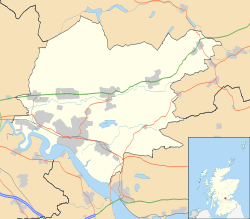Dollar, Clackmannanshire
Coordinates: 56°09′45″N 3°40′05″W / 56.16249°N 3.66814°W
Dollar (Scottish Gaelic: Dolair) is a small town in Clackmannanshire, Scotland. It is one of the Hillfoots Villages, situated between the Ochil Hills range to the north and the River Devon to the south. Dollar is on the A91 road, which runs from Stirling to St Andrews. The town is around 3 miles east of Tillicoultry. The parish of Muckhart extends right up to the eastern edge of Dollar, despite Muckhart's much smaller size. This encompassed Dollar Mine and Pitgober.
The town
The major attraction in Dollar is the 500-year-old Castle Campbell, lowland seat of the Duke of Argyll, where Mary, Queen of Scots once lived in the 16th century. The residence was chosen for its proximity to the court in Edinburgh and to Clackmannan Tower, Alloa, Stirling Castle and Linlithgow Palace.
The walk to the castle is a vigorous ascent by a spectacular series of paths, bridges and walkways in the deep gorges of the glen and its tributaries. Unfortunately, the most spectacular section has had to be closed due to the risk of landslip (a part of which was re-opened Summer 2007), but alternative routes are available. There is also a road to the castle, accessible by car, for the less energetic.
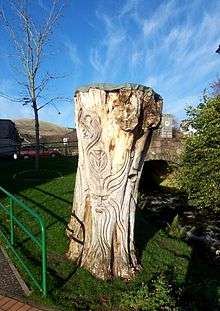
At the foot of Dollar Glen is The Mill Green. Here there is also a small museum run by volunteers, which contains a collection of local items, and much information about the former Devon Valley Railway, which closed to passengers in 1964. There are various sports facilities, including an 18-hole golf course (notable for its steep inclines and lack of bunkers), a tennis club, a squash club, a bowling club, and a cricket club. The Ochil Hills that overlook Dollar provide opportunities for mountain biking. The nearby River Devon is used seasonally for trout fishing (by permit). There are three churches, one Church of Scotland, one Scottish Episcopal Church and Ochil Hills Community Church which meets in the Civic Centre.
Dollar is now mainly residential; however, for a long time it was known for its industries. Attempts were made to mine lead and copper in Dollar Glen from the 18th century and possibly earlier, but these were of no economic significance. Coal mining in the area began around the same time and, until 1973, supplied the Kincardine Power Station, and later, the Longannet Power Station with coal from the Upper Hirst seam. A tiny private non-NCB coal mine operated from the Harviestoun estate from the mid-1970s, partly filling the gap that the closed NCB left, whilst there was still local demand for coal.

In common with the other Hillfoots Villages, the textiles industry played an important part in the town's development. The Harviestoun Brewery was established west of Dollar in 1985, before its move to Alva. The town is now largely a dormitory community for people who work in Stirling and further afield — e.g. Glasgow and Edinburgh. Because of the success of its fee-paying school Dollar Academy and its tranquil environment, the town draws young and reasonably well-off families, giving it a slightly different character from the other Hillfoots Villages.
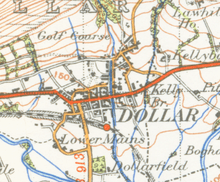
The town has two war memorials, one for each world war. In the grounds of the Academy a bronze figure with outstretched hands faces westwards and commemorates the fallen of the First World War. This also has names added for Northern Ireland. The dead were largely from the Academy; two non-Academy deaths (the Archibald brothers) are indicated by the word "parish" against their names. The Second World War has a far more modest memorial, in the small public garden on the main road, where the road suddenly twists. Both memorials are by local sculptor George Henry Paulin.
Dollar is home of the Dollar Glen Football Club.
Dollar is twinned with the French town of La Ville-aux-Dames, which lies just outside Tours in the Loire Valley.
Origin of name
Possible interpretations are that Dollar is derived from Doilleir, an Irish and Scots Gaelic word meaning dark and gloomy, or from various words in Pictish: 'Dol' (field) + 'Ar' (arable) or Dol (valley) + Ar (high).[3] Another derivation is from Dolar, ‘haugh place’[4] (cf Welsh dôl ‘meadow’. This word was borrowed from British or Pictish into Scottish Gaelic as dail ‘water-meadow, haugh’). John Everett-Heath, in [5] derives it as 'Place of the Water Meadow' from the Celtic dôl 'water meadow' and ar 'place'.
Notable people
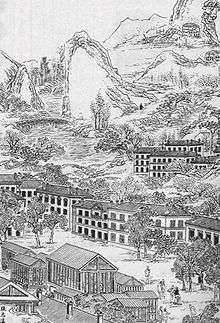
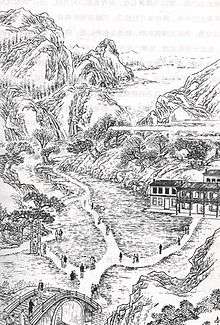
- According to the Pictish Chronicle, Amlaíb Conung, the first Norse king of Dublin, was killed in a battle fought at Dollar around 874, when Constantine I was the king of Scotland.
- Robert Burns visited Dollar in 1787, staying on the Harviestoun estate. There he was inspired to write the song "The Banks of Devon"[6]
- Dollar was the home town of Scottish sinologist James Legge, the translator of The Chinese Classics, who invited Wang Tao to live in Dollar from 1870-1872 where he wrote two travel notes: Wondering in the Rambling Park and Touring the Mountain in Dollar, later published in Jottings from Carefree Travel, the very first travel book about Europe by a Chinese scholar. Wang Tao described the residents of Dollar as "honest, self-sufficient and hard-working" and that "public order is well maintained".[7]
- Dollar Academy was founded in 1818 with a bequest from a Dollar native, Captain John McNabb, who had allegedly made his fortune in the slave trade. Amongst the many notable pupils at the Academy are James Dewar, the inventor of the vacuum flask; the grandsons of Haile Selassie I of Ethiopia;[8] the second Presiding Officer (Speaker) of the Scottish Parliament, George Reid; BBC Gaza correspondent Alan Johnston; and political journalist for The Scotsman, the News of the World and The Spectator magazines, Fraser Nelson.
- Lavinia Malcolm, Provost of Dollar between 1913-1919, was both the first lady provost and first lady town councilor in Scotland (see ).
- The painter J. M. W. Turner visited Dollar and made sketches in the glen.
- In the late 1990s, Michael Kulas and Saul Davies, musicians in the English rock group James, also resided and worked out of the old Tea House Cottage, now known as Brewlands, next to Castle Campbell.
- The Scottish author Iain Banks studied at the nearby University of Stirling and, in an interview for The South Bank Show in 1997, spoke about using the landscape above Dollar as inspiration for his novels (in particular A Song of Stone).
- The noted Esperantist William Auld, nominated three times for the Nobel Prize in Literature, lived in Dollar until his death in 2006.
- The biologist Alan Grafen.
References
- ↑ "Comparative Population Profile: Dollar Locality". Scotland's Census Results Online. 2001-04-29. Retrieved 2008-09-02.
- ↑ http://www.gro-scotland.gov.uk/statistics/publications-and-data
- ↑ Bruce Baillie, Dollar Museum website, 2002
- ↑ Iain Mac an Tàilleir: Scottish placenames, 2003
- ↑ The Concise Dictionary of World Place-Names (2 ed.), Oxford University Press 2012 ISBN 9780199580897 (online at http://www.oxfordreference.com/view/10.1093/acref/9780199580897.001.0001/acref-9780199580897-e-8538?rskey=2DcKF5&result=2&q=Dollar)
- ↑ http://www.robertburns.org/encyclopedia/DevonRiver.281.shtml
- ↑ Wong, Y T (1974). "Reviewed Work: Between Tradition and Modernity: Wang T'ao and Reform in Late-Ch'ing China. Harvard East Asian Series, No. 77 by Paul A. Cohen". Monumenta Serica. 31: 619–620. JSTOR (subscription reqd.) 40726188 (subscription reqd.).
- ↑ Horlock, Rob (2005). How Was It for You?: Memories of the 1940s. Bloomington, Indiana: Unlimited Publishing LLC.
External links
| Wikimedia Commons has media related to Dollar, Clackmannanshire. |
| Wikivoyage has a travel guide for Dollar. |
- Dollar museum
- Dollar Library
- ClacksNet - Clackmannanshire's Community Network
- Look Aboot Ye - Clackmannanshire Community News, Information and Forums
- Historical information on Dollar from the Vision of Britain website
- Dollar Squash Club
- Dollar Glen Football Club homepage
